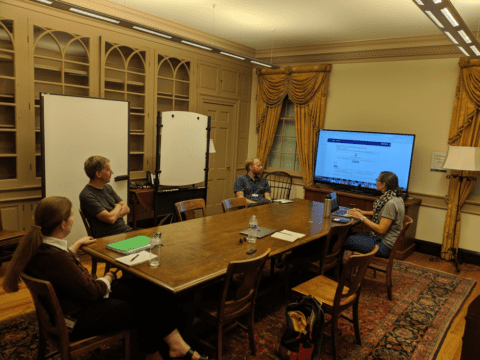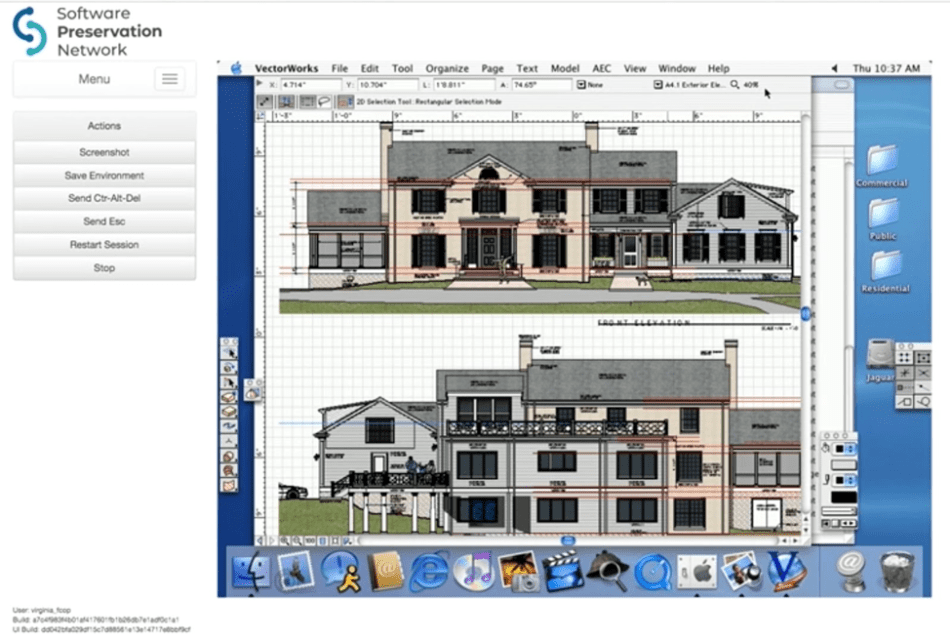University of Virginia: Keeping Software Present with Emulation in the Archives
It’s been a few months since my last fieldwork visit for the FCoP project! In August, I was hosted by cohort team member Lauren Work at the UVA Library. Lauren is the Digital Preservation Librarian and a FCoP team lead for the “Emulation in the Archives” project at UVA. The overall goal of UVA’s team project is to share workflows that come from the team’s experiences developing and testing approaches for the preservation and emulation of the Peter Sheeran papers. The Sheeran collection is from a local Charlottesville architecture firm, and is comprised of many software dependent items, including CAD (Computer Aided Design) files and Building Information Modeling Software. Because the collection includes architecture software with license keys in addition to the software dependent CAD files for building projects, it has proven to be an ideal case study to test and document workflows using the EaaSI platform.

For three days, I shadowed Lauren as she collaborated with library colleagues as well as the FCoP team members throughout the library facilities at UVA. I was able to interview a number of staff and team members in the library that are responsible for digital content management, archival processing, and metadata access. These interviews and observing team meetings allowed me to learn more about UVA’s approach to providing access with adaptable, tested, and well-documented preservation workflows. Most of our meetings and interviews took place in the Mount Vernon Room which is a replica of George Washington’s library at Mount Vernon with the addition of some modernized office equipment. Thinking through the challenges and advantages of emulation for software preservation with FCoP members in this reading room styled to look like President Washington’s personal library was a real treat for me as a researcher because it felt like we were time traveling to an analog emulation of an architectural experience from the 1750s.
A major contribution of the UVA project to the FCoP project has been to design, develop, and document meaningful access experiences to software-dependent archival documents through an emulated environment. With their emphasis on developing workflows, Lauren and colleagues at the library are running user experience research to test users’ assumptions about the arrangement, access, and discovery to records in an emulated environment like Mac OS X Jaguar (10.2) alongside their research on administrative and technical workflows for preservation. As part of this work, Lauren and her colleagues integrated a small amount of user testing during the free Emulation in the Archives workshop they ran in July of this year, hope to continue to run some testing through the end of the grant. During my last day, I participated in a user study with Lauren, where I opened a specific architectural plan and tried to find a few layers of the CAD file. We recorded the audio and the screen of this talk aloud session together.

During my user study, I talked through the paths I was taking, poking around the environment, and asking questions about what I hoped to find. While OS X Jaguar was my first operating system environment from college, there were actions and flows in the system I had completely forgotten. In their work on documenting and generalizing these emulation workflows, Lauren and the team are confronting the challenges of all the different possibilities for providing access. This also includes imagining all the possible kinds of users and the knowledge they will bring to the emulation experience. For example, can we assume that a user will know what the spinning beachball means in the OS X environment? Will a user know how to retrace their steps if they accidentally open an image file in the Quicktime application? These questions, for the UVA team, also include how access and understanding will look from the public services side. How much are staff expected to learn and know about troubleshooting with users in emulated environments? What do sustainable workflows and training look like? How do we prepare researchers for access to these environments?
Like most of the preservationists I interviewed this summer, there are many access strategies, but what each strategy may mean for committing support, resources, and attention in anticipation of future users is still open and unknown. Indeed, it will likely involve threading together different born digital workflows, weaving together curation efforts across different preservation experts, and criss-crossing back and forth between organizational units. In earlier eras of digital preservation research and training, digitization strategies that anticipated what users would need and what they would want to access typically fell on a spectrum between “just-in-time” and “just-in-case” digitization projects. For example, just-in-time scenarios would involve digitizing on a case by case basis, where just-in-case strategies would involve digitizing collections en masse. With software emulation, the challenge of supporting long-term access moves beyond anticipating what people will want and rests in work of maintaining software by keeping it present, or what Marissa Leavitt Cohn calls, “the work of bringing old code together with new, and managing software change in ways that interoperate with legacy systems (2019, p. 427).
For their current FCOP use case and grant deliverables, including descriptive workflows, technical workflows, and curatorial checklists, the UVA team has found that the “just-in-time” approach suits some of the current realities and unknowns for software preservation and emulation work. Current versions of their archival description strategy for software (which can be reviewed here) is an illustrative example of this idea in practice. In their user experience research and workflow documentation efforts, the UVA FCoP team is gathering empirical evidence to inform preservationists, curators, and archivists in the near future to make decisions and manage what they have termed “saved state” environments for a range of potential emulation experiences. The presentation of an emulation environment to a saved state is a way of presenting multiple narrative forms with emulation, by keeping old and obsolete software present. Creating an emulation workflow that is both technical and curatorially comprehensive is and will continue to be a non-trivial task for software preservationists, like Lauren and her team. It remains to be seen whether completely emulated collections (just-in-case) or use-driven (just-in-time) emulation experiences will win out as best practices, but in all likelihood, the future of emulation for archival access will involve techniques from both strategies, perhaps even more hybrid approaches to ‘keeping software present’. Software maintainers, like Lauren and other FCoP cohort members across many sites, are each confronting how software continues to evolve even as they are trying to preserve it in the present for future access scenarios. It is this maintenance of keeping software present and rendering it visible to potential users with emulation scenarios that has yet to be researched, standardized, and theorized in contemporary approaches to software preservation.